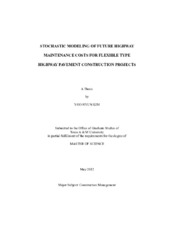| dc.description.abstract | The transportation infrastructure systems in the United States were built between the 50's and 80's, with 20 years design life. As most of them already exceeded their original life expectancy, state transportation agencies (STAs) are now under increased needs to rebuild deteriorated transportation networks. For major highway maintenance projects, a federal rule enforces to perform a life-cycle cost analysis (LCCA).
The lack of analytical methods for LCCA creates many challenges of STAs to comply with the rule. To address these critical issues, this study aims at developing a new methodology for quantifying the future maintenance cost to assist STAs in performing a LCCA. The major objectives of this research are twofold: 1) identify the critical factors that affect pavement performances; 2) develop a stochastic model that predicts future maintenance costs of flexible-type pavement in Texas.
The study data were gathered through the Pavement Management Information System (PMIS) containing more than 190,000 highway sections in Texas. These data were then grouped by critical performance-driven factor which was identified by K-means cluster analysis. Many factors were evaluated to identify the most critical factors that affect pavement maintenance need. With these data, a series of regression analyses were carried out to develop predictive models. Lastly, a validation study with PRESS statistics was conducted to evaluate reliability of the model. The research results reveal that three factors, annual average temperature, annual precipitation, and pavement age, were the most critical factors under very low traffic volume conditions.
This research effort was the first of its kind undertaken in this subject. The maintenance cost lookup tables and stochastic model will assist STAs in carrying out a LCCA, with the reliable estimation of maintenance costs. This research also provides the research community with the first view and systematic estimation method that STAs can use to determine long-term maintenance costs in estimating life-cycle costs. It will reduce the agency's expenses in the time and effort required for conducting a LCCA. Estimating long-term maintenance cost is a core component of the LCCA. Therefore, methods developed from this project have the great potential to improve the accuracy of LCCA. | en |


